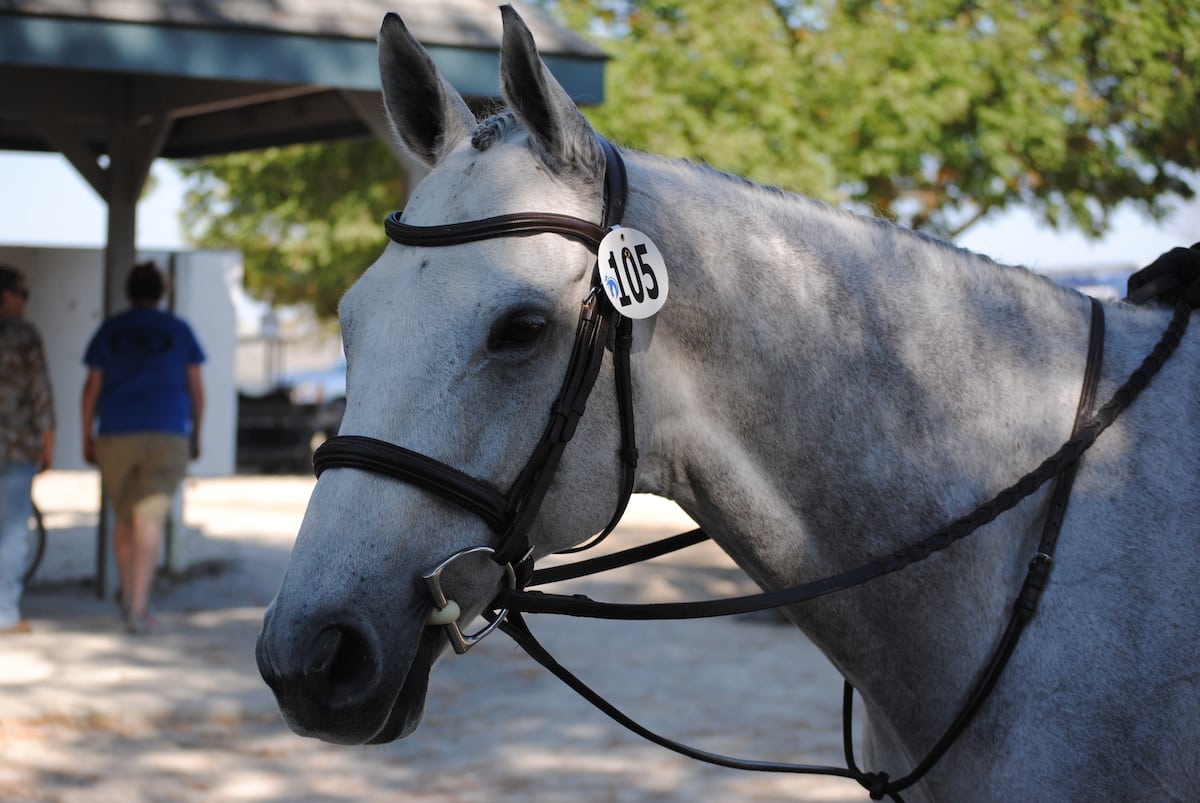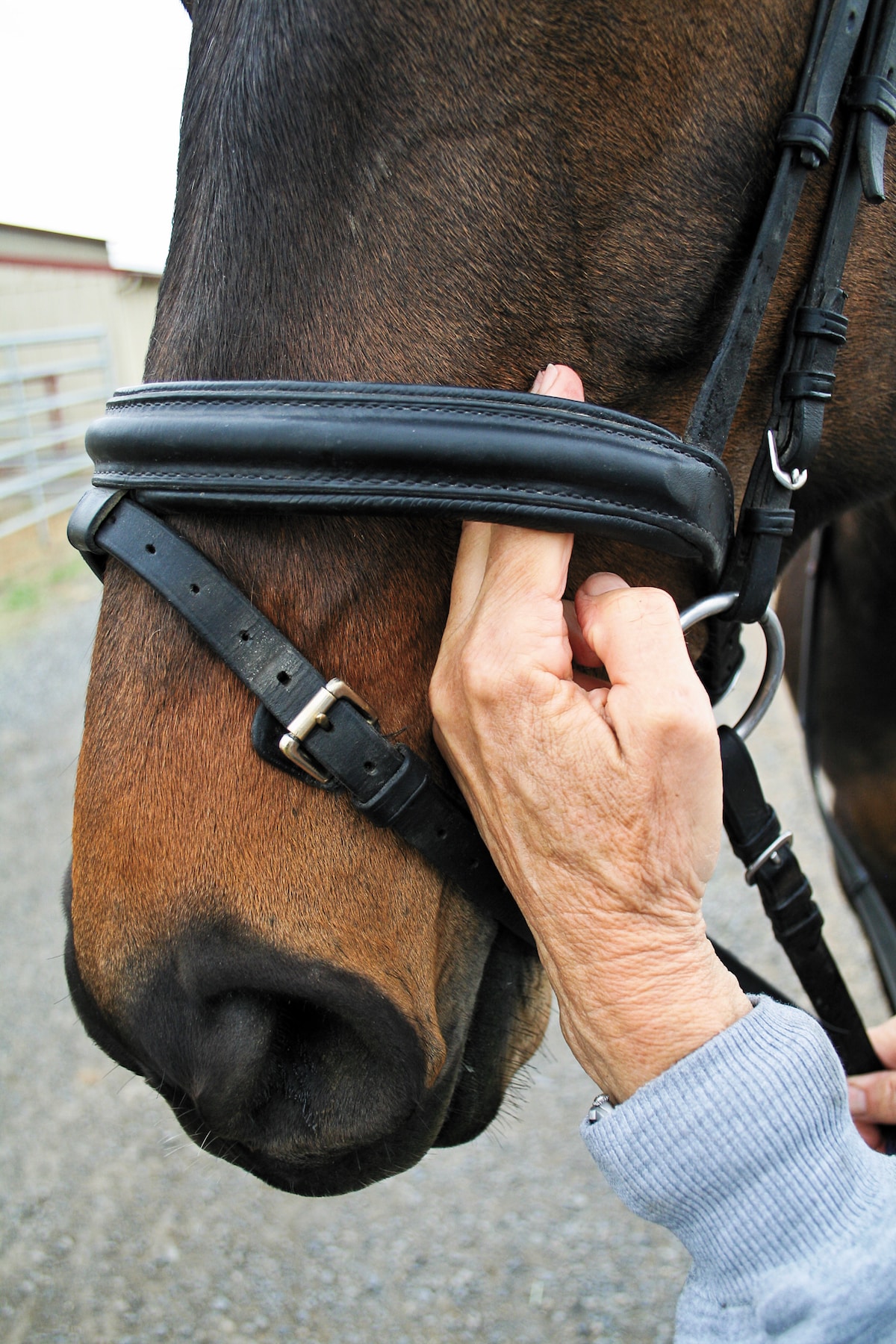How to choose the right bit and bridle for your OTTB

A properly fitted bridle does not place too much pressure around the horse’s ears, poll or nasal structures, and the bit should form a small wrinkle in the corners of the lips. Kristen Kovatch Bentley photo
When you begin retraining an ex-racehorse for a riding career, you’re not just giving him different cues and functions than he’s accustomed to, you’re also changing his tack and the way it operates. That includes the bit and bridle you use to connect and communicate with your horse.
A big part of setting your OTTB up for success in his new career is outfitting him with properly fitted — and appropriate — headgear and adjusting equipment choices as he progresses in his training. It’s a simple concept that can get complicated fast. And, as we know, one of our goals when retraining these horses is keeping things simple and low-stress.
So we turned to Hilary Clayton, BVMS, PhD, Dipl. ACVSMR, FRCVS, a Michigan-based veterinarian, horsewoman and Grand Prix dressage rider who’s spent years studying bit and bridle mechanics, and Leandra Cooper, trainer and facility manager at New Vocations Racehorse Adoption Program’s Lexington, Kentucky, farm, for wisdom on the array of bits and bridles at our disposal.
Step One: Keep it Simple
In her role Cooper manages and trains horses — mostly ages 2 to 5 — either coming straight from the track or following rehab and/or R&R. Regardless, they’ve had no other post-track training, and she uses the same process to select a bridle and bit for each horse.
“A horse’s head anatomy has a lot to do with bridle choice, but all of ours start in something pretty simple — a plain cavesson with a raised noseband is our go-to,” she says. “As far as bits go, for 99% of them we use either a D-ring or loose-ring snaffle with a middle joint piece (such as a French link) to, as best we can, evenly distribute the pressure across their mouth and their tongue.”.”
Cooper says some horses can be incredibly strong in a normal snaffle in the early stages of retraining. “You literally can’t stop them,” she says. In those situations she says she might try something like a slow-twist snaffle “just to be able to have control when you need it.”
A quick but important side note to remember: “The way you use the bit is most important,” she adds. “You could use something that’s considered a more severe bit, but in an advanced rider’s hands it’s going to be softer than a single-joint D-ring that’s banging the top of their mouth because someone (less proficient) is hammering on their face.”
Cooper says she’s had excellent experiences with bits made from composite metals. “I think it makes a huge difference when you want to create a suppling effect. It helps to have something that’s a little sweeter and that’s going to warm up faster.”
She adds that one reason she keeps it simple, rarely using nosebands or tools that substantially manipulate the jaw on new arrivals, is because she wants to see what issues, if any, develop and then fix them properly rather than masking them.
“I like to keep a really raw feel, which is the same reason I don’t really use martingales on them; I consider that a tool for a more experienced horse,” she says. “A lot of these guys have had different sorts of things used on them on the track, and it’s not so much that they can’t handle it mentally, but everything changes so much during retraining. You’re changing the whole way they think about tack and the whole way it’s used, so I want to keep everything as simple as possible, figure out what we need to work on and go from there.”
Don’t Downplay Proper Fit
We’ve all been taught the importance of a properly fitting saddle, but our sources say bit and bridle fit are just as critical.
“Proper fit is important so that the horse feels comfortable and can concentrate on his job,” Clayton says. “The effects of ill-fitting tack may cause mild discomfort, in which case the horse is likely to be distracted, resistant to rein aids and not taking a contact with the rider’s hand. In some instances the tack can be downright painful, causing injury to the head or mouth.”
When fitting a bridle, she says, keep these key concepts in mind, regardless of what type you choose:
■ Avoid placing pressure around the horse’s ears. “A browband that’s too short pulls the crown piece forward against the back of the ears,” Clayton says. “Measure carefully for a browband, and don’t use one that’s too tight.”
Additionally, if your bridle has a crown piece with ear cutouts (which can help reduce pressure around the ears), ensure it’s not causing more problems than it’s fixing: “Horses have different conformations, so make sure the crown piece you choose is shaped in the correct place for your horse’s ears,” she says.
■ Reduce poll pressure with a wide, padded crownpiece. “The poll is a sensitive area,” Clayton says. “Always feel the (bridle’s) padding to assess whether it will conform to the horse’s shape. Some bridles are padded with firm material that doesn’t conform to the contours of the horse’s head.”
■ Don’t overtighten the noseband. “There has been a lot of criticism in recent years of riders overtightening the noseband to keep the horse’s mouth closed,” she says. Excessively tight nosebands can also place painful pressure on the outer edges of the nasal bones and on the edges of the mandible (lower jaw), she adds.
A good rule of thumb is to be sure you can insert two fingers beneath the noseband at the side of the head; if you can’t, it’s too tight. “Don’t put your fingers under the noseband on the bridge of the nose because they could be crushed if the horse opens his mouth,” Clayton cautions.
“Thick, soft, conformable padding is especially important in these areas, and many trainers choose a Swedish noseband because they are padded not only over the nose, but also under the jaw,” she adds.
■ Adjust flash nosebands carefully. Used and adjusted properly, the flash attachment stabilizes the bit in the horse’s mouth and helps him learn to keep his mouth closed. “The horse should be able to move his jaws to chew the bit, but when his mouth is opened too wide the noseband puts pressure on his face,” Clayton says. “As soon as the horse closes his mouth he is rewarded because the pressure goes away. This is called negative reinforcement.”
Applied too tight, however, it can cause serious discomfort. The flash should be loose enough that the horse can chew gently on the bit and not so tight as to pull the cavesson down. That said, ensure it’s snug enough that it doesn’t flop around and distract your horse.
■ Take time with bit-fitting. Yes, it can be tedious, but ensuring proper bit fit is a must. “If the bit is either too wide or not wide enough for the horse’s mouth, it’s likely to cause abrasions or ulcers at the corners of the lips,” Clayton says. “A bit that’s too low on the tongue makes horses fussy, but a bit that’s too high may cut the corners of the lips. And a bit that’s not an appropriate shape for the horse’s mouth may put pressure on the roof of the mouth (the hard palate), which is a very sensitive area.”
Clayton says she prefers to adjust the bit so it “very slightly lifts the corner of the lips, forming a small wrinkle.”
Once you’ve fit your bridle and bit properly, put your horse to work, and pay close attention to his acceptance of the setup.

Be sure you can insert two fingers beneath the noseband at the side of the head; if you can’t, it’s too tight. Courtesy The Horse staff
Stick With a Snaffle or Change it Up?
Some horses go happily in a snaffle, whatever the variety, for their entire careers. But riders might consider a different bit if the horse is fussy with it or if they need more control, for example, when jumping or riding cross-country. Before you reach for something new, our sources have a few points to consider:
“Most of the bits that a rider might transition to from a snaffle are regarded as having the potential to be more severe if used incorrectly,” Clayton says. “This implies that the rider should have an independent seat and be able to control their position in the saddle without relying on the reins for balance or support.”
Also, know exactly what you’re hoping to address.
“Once you get to know your horse and you’ve worked through the baby stages, maybe you need more straightness so you try a full-cheek, or maybe you need more lift so you try an elevator,” says Cooper. “But most of the time when people blame the bit, they should take a closer look at themselves.
“There are plenty of people I’ve known that chronically switch their bit,” she continues. “The horse goes really well for a couple weeks, then they get used to it, then they develop the same problems. The common denominator here is that it’s probably not the bit — it’s a rider or training issue. You just introduced a subtle change that distracted your horse for a little while. There are very few things you’re going to completely resolve by just switching a bit.”
This is where working with a trainer can be incredibly useful to help dissect issues and recommend a different bit, if needed. “Many trainers have a bit box with a selection of bit types,” Clayton says, “and some tack stores have a try-before-you-buy program. We also have qualified bit fitters who are trained in this area and will come to you with a big selection of bits that you can try riding with, and they give professional feedback and suggest alternatives.”
Prioritize Horse Happiness
Finding the right bit and bridle combination sometimes takes trial and error. The No. 1 thing to remember when doing so is to keep it simple.
“Get the softest, least intrusive thing you can get that’s not super thick, not super thin,” Cooper says. “Keep it as simple as possible. If you can keep a simpler bit and develop them so they can use their hind end and support themselves, you might not need that three-ring elevator.”
Adds Clayton, “It pays to take your time in the beginning. Go back to basics and be prepared to go as slowly as you need to for your horse to adapt to the new tack, learn the new aids and perform like a superstar. I don’t really think it matters which hat I wear — veterinarian, researcher or horseman — the horse comes first and will tell you if he’s not happy. We need to listen and act accordingly.”
Ergonomic Bridles: Fad or Fabulous?
Tack technology has advanced significantly in recent years. Manufacturers have debuted ergonomic bridles designed to reduce pressure on sensitive areas of the horse’s head and apply appropriate pressure to different points.
“I think the Micklem bridle is a good example of how this can be achieved,” says Hilary Clayton, BVMS, PhD, Dipl. ACVSMR, FRCVS, a Michigan-based veterinarian, horsewoman and Grand Prix dressage rider. “And many of the newer ergonomic bridles employ the same principles as the Micklem but with slightly different shapes and accessories.”
Whether an ergonomic bridle works for a horse depends on the individual.
“Some love it, some really don’t like it,” says Leandra Cooper, trainer and facility manager at New Vocations Racehorse Adoption Program’s Lexington, Kentucky, farm. “You can have the same exact bit and change the bridle and have a completely different response. You could ask for a halt, and all of a sudden they’re threatening to rear. You just have to listen to what the horse is telling you.”
One important consideration: Fitting ergonomic bridles might be slightly different than fitting the traditional snaffle bridle. Consult the product guides or website to ensure you’ve fitted the bridle appropriately prior to use.
This article was originally published in the Spring 2021 issue of Off-Track Thoroughbred Magazine, the only publication dedicated to the Thoroughbred ex-racehorse in second careers. Want four information-packed issues a year delivered to your door or your favorite digital device? Subscribe now!

